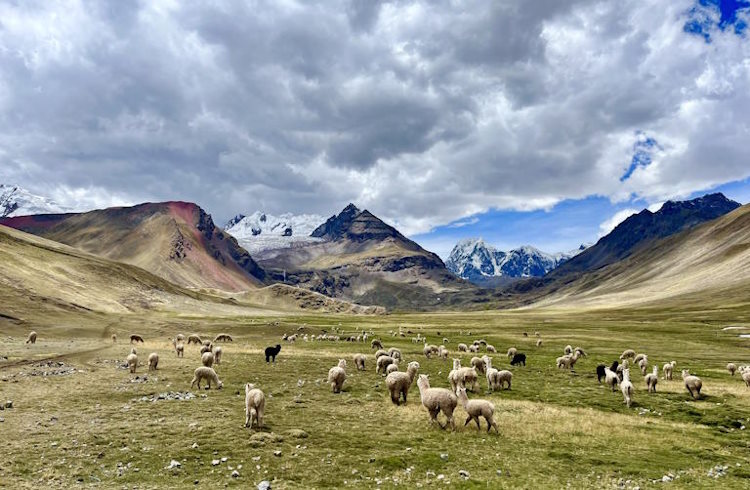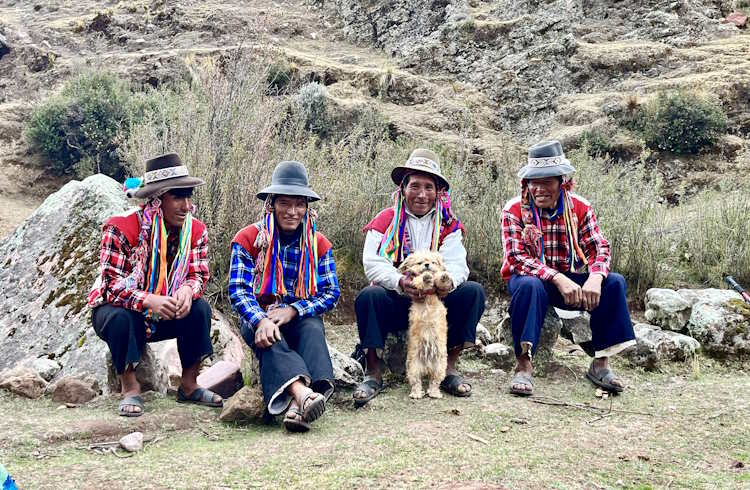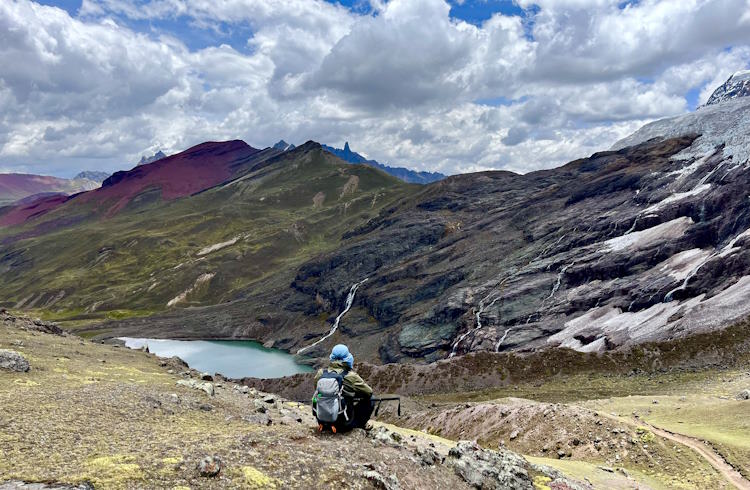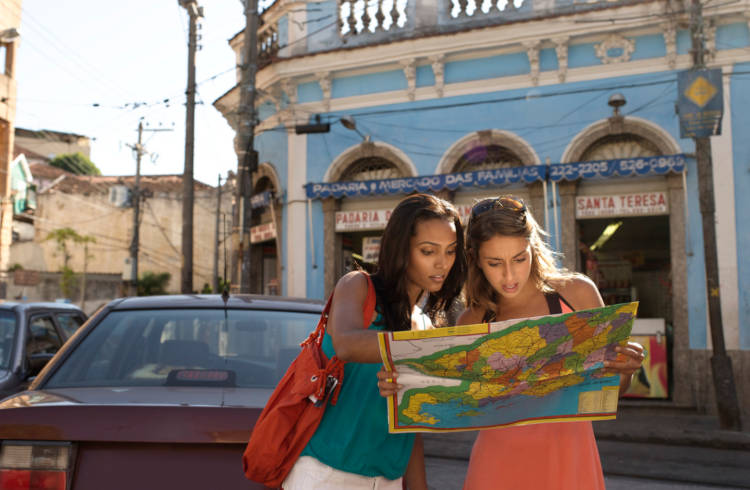Ausangate Trek: 5 Magic Days in the Peruvian Andes
Far less traveled than the Inca Trail, this trek around sacred Ausangate mountain offers spectacular scenery, comfortable lodging, and opportunities to visit local communities.
Shares
 Photo © Megan FitzGerald
Photo © Megan FitzGerald
It’s a blustery afternoon in Ocefina, Peru, and we are trudging through its rugged green valley, eyed warily by the thousands of llamas and alpacas that litter the mountainsides. Our guides are Jesús, a permanent grin beneath a heavy cap, and Josef, younger and more reserved, who both bounce alongside our group, merrily informing us about the flora and fauna of the area, its customs and history, its people and their lives. My spirits are high as I take it all in but I’m still nervous for what lies ahead.
Ausangate, Peru’s 5th highest peak, sits approximately 62mi (100km) southeast of Cusco in the south of Peru. Looming at 20,905ft (6,372m) above sea level, this mountain dominates the Vilcanota mountain range, an imposing, icy figure standing well above its neighbors. But despite its intimidating aura, Ausangate has an undeniable beauty to it, and right now travelers can enjoy a truly unique experience within its domain.
Hiking Ausangate Mountain
Beginning and ending in the rural community of Ocefina, we’ll be hiking 34mi (55km) over five days on a looping route that passes the base of the giant peak, visiting the local Andean communities that have called this area home for generations on the way. Although most travelers come to Peru for Machu Picchu or the Inca Trail, this Ausangate trail lets you dive deep into the nooks and crannies of rural Cusco, while retaining some home comforts: we’re staying in traditional, community-run Andean lodges, heated by open fires and served delicious food prepared by a talented local team – perfect for the traveler who wants to challenge themselves by day but sleep in a comfy bed at night.
It might sound dreamy, but it’s not going to be a walk in the park. The entire trek never drops below 13,120ft (4,000m) and we’ll be scaling multiple steep passes; I’m no natural-born hiker, but this would be challenging for almost anyone. Thankfully, our first day begins relatively easily: after a three-hour drive from Cusco, we jump out into the crisp air and are immediately greeted by the local ladies of Ocefina for a short masterclass into their native textile weavings, creating stunning handmade crafts found only in this area. It’s the perfect chance to buy anything we might’ve forgotten for the journey, as well as supporting the ladies’ local economy.
Comfortable eco lodges
After an hours’ walk through the lush, green community of Chillca, we arrive at our first lodge and meet the team we’ll be traveling with. We have a small army of horsemen carrying our food supplies and acting as potential “ambulances”, llamamen with our possessions strapped to their flock, chefs producing lunches and dinners of fresh salads, quinoa soups, and local trout, and housekeeping ladies all working together to look after us on our journey. All of this has been arranged by Cusco-based Andean Lodges in partnership with Tropic, a company that works behind the scenes to craft thoughtful itineraries for travelers mostly in Peru and Ecuador. I take a warm shower in a private bathroom, then fall into a dead sleep, surrounded by candlelight and hot water bottles, while the outside temperatures plummet.

After a hearty breakfast of coca tea, eggs, and fresh bread (cheered on by hand-carved fruit animals) the real work begins on our second day as we move onto Machuracay. Jesús is invaluable as our guide, pointing out hidden secrets in the land: a cave where a native owl perches, or a Giant Hummingbird skirting the high rocks. Though it’s an unforgiving landscape, more than 110 species of bird and 25 species of mammals frequent this region, so we crane our necks as we move along on this unexpected safari.
Tackling Palomani Pass
We ascend higher and the air cools. We navigate glaciers and turquoise bodies of water that appear as the grass fades into rocky terrain, and I have to admit it's exhausting. Watching our local companions skip past gives me motivation to continue, even just out of embarrassment, and I manage to climb further, until I find myself clinging to the sharp incline of the ochre-colored Palomani Pass at 16,730ft (5,100m). The twin bowls of nothingness on either side of me are so vast I can’t help but envision myself floating off into the stratosphere like some sort of rogue astronaut, and this fleeting feeling of gravity-based confusion keeps recurring. Every now and then, as I take in exactly where I am, gazing down at the vast basin of Lake Ausangate, or hearing the cannon-fire echoes of glaciers cracking, the feeling of being in the normal world leaves me.

Perhaps that’s the point – Ausangate is intensely sacred, not seen just as a mountain but as a god – and revered by the locals that call the area home. Julio, one of our llamamen, blesses us before we enter its region, asking for our protection as we navigate its rocky terrain. We each place three coca leaves on a small cloth along with some other offerings (thread, corn kernels, cookies), which Julio folds into a bundle and sets alight, sending smoke plumes skyward. I’m not a spiritual person at all, but I find myself unexpectedly emotional being given the chance to pray to Ausangate for assistance. Maybe I’m still nervous.
A certain energy permeates the air as we continue. It’s not lost on me how lucky we are to be in such a special place.
A visit to Rainbow Mountain
Our fourth day brings us to Rainbow Mountain, a kaleidoscopic landscape of reds, greens, and blues, formed by rich natural iron and magnesium deposits, and is, somewhat inevitably, hugely popular with tourists – around 1,500 a day. We’re all slightly perplexed: after days of having only each other and the landscape for company, to suddenly hear ATVs roaring up the hillside from Cusco and see swarms of people on the mountaintops is slightly jarring. “I have nothing against people,” Jesús chirps from next to me as we pause, “but I love places without them.” I can’t help but agree. Our previous days' trekking have spoiled us, and as gorgeous as Rainbow Mountain is, it’s just one part of a huge amalgamation of color and landscape in this stunning area; the joy of this journey is that we get to see so much more of it.
We spend some time navigating the crowds before scurrying through a distant archway and on to Red Valley, where the faces of the sleeping Pururauca are etched into the mountainside. It’s as if we plunge back into the secret world we were in before, and the shift in environment is extreme – it’s a prehistoric-feeling land, where the mountains are the backs of giant, dark monsters, sharp and jagged in comparison to the woozy green vistas of before. After a final night sleeping under a thundering sky, we spend our last day climbing the final Anta Pass, then running (literally) entirely downhill, before we say goodbye to our hosts back in Ocefina.
It feels strange to be such a small group again, and as we rumble back to Cusco to the sound of car horns and revving engines, I find myself already missing the mountains. My new friends drive away and I step onto the cobbled street I stood on five days before and gaze at the mountain-line in the distance, wondering where I’ll trek next.
Related articles
Simple and flexible travel insurance
You can buy at home or while traveling, and claim online from anywhere in the world. With 150+ adventure activities covered and 24/7 emergency assistance.
Get a quote


1 Comment
I felt like I was there too, and now really want to go there. How lovely to be so immersed in that landscape.